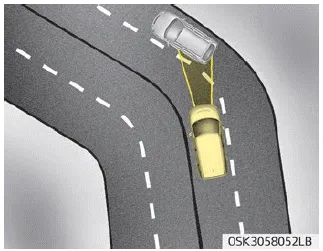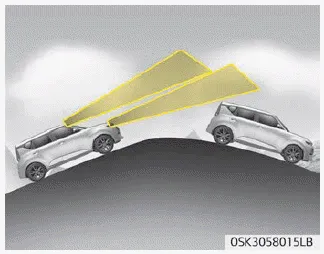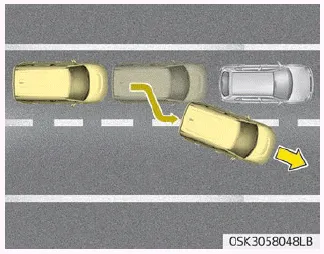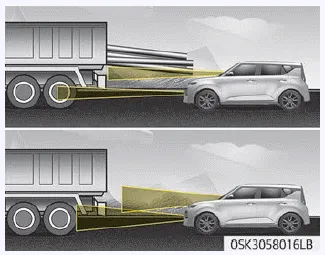Kia Soul (SK3): Forward Collision-Avoidance Assist (FCA) system (Camera +Radar type) / Limitations of the system
FCA is an assistant system for a driver in a certain risky driving condition and it does not take every responsibility for all risks from driving condition.
FCA monitors the driving situations through the radar and the camera sensor. Thus, for a situation out of the sensing range, FCA may not normally operate. The driver should pay great caution in the following situations. FCA operation may be limited.
Recognizing vehicles
The sensor may be limited when:
- The radar sensor or camera is blocked with a foreign object or debris.
- The camera lens is contaminated due to tinted, filmed or coated windshield, damaged glass, or stuck of foreign matter (sticker, bug, etc.) on the glass.
- Inclement weather such as heavy rain or snow obscures the field of view of the radar sensor or camera.
- There is interference by electromagnetic waves.
- There is severe irregular reflection from the radar sensor.
- The radar/camera sensor recognition is limited.
- The vehicle in front is too small to be detected (for example a motorcycle etc.).
- The vehicle in front is an oversize vehicle or trailer that is too big to be detected by the camera recognition system (for example a tractor trailer, etc.).
- The camera's field of view is not well illuminated (either too dark or too much reflection or too much backlight that obscures the field of view).
- The vehicle in front does not have their rear lights or their rear lights does not turned ON or their rear lights are located unusually.
- The outside brightness changes suddenly, for example when entering or exiting a tunnel.
- When light coming from a street light or an oncoming vehicle is reflected on a wet road surface such as a puddle in the road.
- The field of view in front is obstructed by sun glare.
- The windshield glass is fogged up; a clear view of the road is obstructed.
- The vehicle in front is driving erratically.
- The vehicle is on unpaved or uneven rough surfaces, or road with sudden gradient changes.
- The vehicle is driven near areas containing metal substances as a construction zone, railroad, etc.
- The vehicle drives inside a building, such as a basement parking lot.
- The camera does not recognize the entire vehicle in front.
- The camera is damaged.
- The brightness outside is too low such as when the headlamps are not on at night or the vehicle is going through a tunnel.
- The shadow is on the road by a median strip, trees, etc.
- The vehicle drives through a tollgate.
- The windshield glass is fogged up; a clear view of the road is obstructed.
- The rear part of the vehicle in front is not normally visible. (the vehicle turns in other direction or the vehicle is overturned.)
- The adverse road conditions cause excessive vehicle vibrations while driving.
- The sensor recognition changes suddenly when passing over a speed bump.
- The vehicle in front is moving vertically to the driving direction.
- The vehicle in front is stopped vertically.
- The vehicle in front is driving towards your vehicle or reversing.
- You are on a roundabout and the vehicle in front circles.

- Driving on a curve
FCA performance decreases while driving on a curve. FCA may not recognize the vehicle in front even in the same lane. It may unnecessarily produce the warning message and the warning alarm, or it may not produce the warning message and the warning alarm at all.
While driving on a curve, pay great caution, and, if necessary, depress the brake pedal.

While driving on a curve, FCA may recognize the vehicle in front in the next lane. Pay great caution, and, if necessary, depress the brake pedal. Or, depress the accelerator pedal to maintain the driving speed. Always, take a look around the vehicle for your safety.

- Driving on a slope
FCA performance decreases while driving upward or downward on a slope, not recognizing the vehicle in front in the same lane. It may unnecessarily produce the warning message and the warning alarm, or it may not produce the warning message and the warning alarm at all. When FCA suddenly recognizes the vehicle in front while passing over a slope, you may experience sharp deceleration.
Always keep your eyes forward while driving upward or downward on a slope, and, if necessary, depress the brake pedal.

- Changing lanes
Even though the vehicle in the next lane enters into your lane, it may not be recognized by FCA, until it enters FCA sensing range.
Especially when the vehicle in the next lane abruptly enters into your lane, it is more likely not be recognized. Always pay great attention.

When driving in stop-and-go traffic, and a stopped vehicle in front of you merges out of the lane, FCA system may not immediately detect the new vehicle that is now in front of you. In this case, you must maintain a safe braking distance, and if necessary, depress the brake pedal to reduce your driving speed in order to maintain a safe distance.

- Recognizing the vehicle
Detecting the vehicle in front of you if the vehicle in front of you has cargo that extends rearward from the cab, or when the vehicle in front of you has higher ground clearance, additional special attention is required. FCA system may not be able to detect the cargo extending from the vehicle. In these instances, you must maintain a safe braking distance from the rearmost object, and if necessary, depress the brake pedal to reduce your driving speed in order to maintain distance.
Recognizing pedestrians
- The pedestrian is not fully captured by the camera sensor, or the pedestrian
does not walk in the upright position.
- The pedestrian moves very fast.
- The pedestrian abruptly appears in front.
- The pedestrian wears clothes in the color similar to the background.
- The outside is too bright or too dark.
- The vehicle drives at night or in the darkness.
- There is an item similar to a person’s body structure.
- The pedestrian is small.
- The pedestrian has impaired mobility.
- It is difficult to distinguish the pedestrian from the surroundings.
- The sensor recognition is limited.
- There is a group of pedestrians.
- If a sudden change in the sensor recognition takes place while passing through
the speed bump.
- When the vehicle is severely shaken.
- When driving around circular intersection after the vehicle in front.
- If the front of the camera lens is contaminated by front glass tinting, film,
water repellent coating, damage on glass, foreign matter (sticker, insect, etc.).
- The radar or camera or camera lens is damaged.
- If the headlights of the vehicle are not used at night or in the tunnel section,
or the light is too weak.
- If street light or the light of the vehicle coming from the opposite is reflected
or when sunlight is reflected by the water on the road surface.
- When the back light is projected in the direction of the vehicle's motion (including
the headlights of vehicles).
- Road sign, shadow on the road, tunnel entrance, toll gate, partial pavement.
- If the windshield has moisture on its surface or if windshield freezes.
- Driving in the fog.
- When objects are out of the sensing range of the sensor or radar.
- When the cyclist in front is riding intersected with the driving direction.
- When there is any other electromagnetic interference.
- When the construction area, rail or other metal object is near the cyclist.
- If the bicycle material is not reflected well on the radar.
WARNING
- Cancel the FCA in the User Settings on the LCD display, before towing another vehicle. While towing, the brake application may adversely affect your vehicle safety.
- Pay great caution to the vehicle in front, when it has heavy loading extended rearward, or when it has higher ground clearance.
- The sensor only detects pedestrian, not carts, bicycles, motorcycles, luggage bags, or strollers.
- FCA does not operate in a certain situation. Thus, never test-operate FCA against a person or an object. It may cause a severe injury or even death.
- When replacing or reinstalling the windshield, front bumper or radar/ camera after removal, have the vehicle inspected by a professional workshop. Kia recommends to visit an authorized Kia dealer/service partner.
NOTICE
The system may temporarily cancel due to the strong electric waves.
When FCA is not working properly, the FCA warning light () will illuminate and the warning message will appear for a few seconds. After the message disappears, the master warning light () will illuminate.
Cruise Control system allows you to program the vehicle to maintain a constant speed without pressing the accelerator pedal. This system is designed to function above approximately 30 km/h (20 mph).
Other information:
Kia Soul (SK3) 2020-2025 Owners Manual: Maintenance Under Severe Usage Conditions - For Gasoline Engine
Maintenance operation I: Inspect and if necessary, adjust, correct, clean or replace. R: Replace or change. SEVERE DRIVING CONDITIONS A: Repeatedly driving short distance of less than 8 km (5 miles) in normal temperature or less than 16 km (10 miles) in freezing temperature.
Kia Soul (SK3) 2020-2025 Owners Manual: Tire replacement
If the tire is worn evenly, a tread wear indicator (A) will appear as a solid band across the tread. This shows there is less than 1.6 mm (1/16 in.) of tread left on the tire. Replace the tire when this happens. Do not wait for the band to appear across the entire tread before replacing the tire.
Categories
- Manuals Home
- Kia Soul Owners Manual
- Maintenance
- Seat
- Engine compartment
- New on site
- Most important about car
